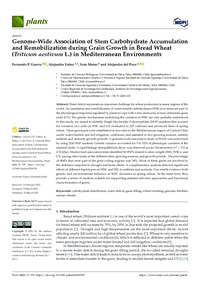Genome-wide association of stem carbohydrate accumulation and remobilization during grain growth in bread wheat (Triticum aestivum L.) in mediterranean environments
Autor
Guerra, Fernando P.
Yañez-Alegría, Alejandra
Matus, Iván A.
Del Pozo, Alejandro
Fecha
2021Resumen
Water deficit represents an important challenge for wheat production in many regions of the world. Accumulation and remobilization of water-soluble carbohydrates (WSCs) in stems are part of the physiological responses regulated by plants to cope with water stress and, in turn, determine grain yield (GY). The genetic mechanisms underlying the variation in WSC are only partially understood. In this study, we aimed to identify Single Nucleotide Polymorphism (SNP) markers that account
for variation in a suite of WSC and GY, evaluated in 225 cultivars and advanced lines of spring wheat. These genotypes were established in two sites in the Mediterranean region of Central Chile, under water-limited and full irrigation conditions, and assessed in two growing seasons, namely anthesis and maturity growth periods. A genome-wide association study (GWAS) was performed by using 3243 SNP markers. Genetic variance accounted for 5 to 52% of phenotypic variation of the
assessed traits. A rapid linkage disequilibrium decay was observed across chromosomes (r 2 ≤ 0.2 at 2.52 kbp). Marker-trait association tests identified 96 SNPs related to stem weight (SW), WSCs, and GY, among other traits, at the different sites, growing seasons, and growth periods. The percentage of SNPs that were part of the gene-coding regions was 34%. Most of these genes are involved in the defensive response to drought and biotic stress. A complimentary analysis detected significant
effects of different haplotypes on WSC and SW, in anthesis and maturity. Our results evidence both genetic and environmental influence on WSC dynamics in spring wheat. At the same time, they provide a series of markers suitable for supporting assisted selection approaches and functional characterization of genes.
Fuente
Plants, 10(3), 539Link de Acceso
Click aquí para ver el documentoIdentificador DOI
doi.org/10.3390/plants10030539Colecciones
La publicación tiene asociados los siguientes ficheros de licencia:


